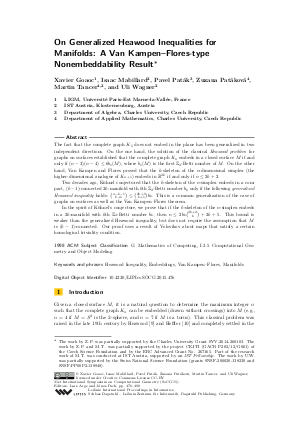On Generalized Heawood Inequalities for Manifolds: A Van Kampen-Flores-type Nonembeddability Result
Authors Xavier Goaoc, Isaac Mabillard, Pavel Paták, Zuzana Patáková, Martin Tancer, Uli Wagner
-
Part of:
Volume:
31st International Symposium on Computational Geometry (SoCG 2015)
Part of: Series: Leibniz International Proceedings in Informatics (LIPIcs)
Part of: Conference: Symposium on Computational Geometry (SoCG) - License:
 Creative Commons Attribution 3.0 Unported license
Creative Commons Attribution 3.0 Unported license
- Publication Date: 2015-06-12
File

PDF
LIPIcs.SOCG.2015.476.pdf
- Filesize: 0.6 MB
- 15 pages
Document Identifiers
Subject Classification
Keywords
- Heawood Inequality
- Embeddings
- Van Kampen–Flores
- Manifolds
Metrics
- Access Statistics
-
Total Accesses (updated on a weekly basis)
0PDF Downloads0Metadata Views
Abstract
The fact that the complete graph K_5 does not embed in the plane has been generalized in two independent directions. On the one hand, the solution of the classical Heawood problem for graphs on surfaces established that the complete graph K_n embeds in a closed surface M if and only if (n-3)(n-4) is at most 6b_1(M), where b_1(M) is the first Z_2-Betti number of M. On the other hand, Van Kampen and Flores proved that the k-skeleton of the n-dimensional simplex (the higher-dimensional analogue of K_{n+1}) embeds in R^{2k} if and only if n is less or equal to 2k+2.
Two decades ago, Kuhnel conjectured that the k-skeleton of the n-simplex embeds in a compact, (k-1)-connected 2k-manifold with kth Z_2-Betti number b_k only if the following generalized Heawood inequality holds: binom{n-k-1}{k+1} is at most binom{2k+1}{k+1} b_k. This is a common generalization of the case of graphs on surfaces as well as the Van Kampen--Flores theorem.
In the spirit of Kuhnel's conjecture, we prove that if the k-skeleton of the n-simplex embeds in a 2k-manifold with kth Z_2-Betti number b_k, then n is at most 2b_k binom{2k+2}{k} + 2k + 5. This bound is weaker than the generalized Heawood inequality, but does not require the assumption that M is (k-1)-connected. Our proof uses a result of Volovikov about maps that satisfy a certain homological triviality condition.
Cite As Get BibTex
Xavier Goaoc, Isaac Mabillard, Pavel Paták, Zuzana Patáková, Martin Tancer, and Uli Wagner. On Generalized Heawood Inequalities for Manifolds: A Van Kampen-Flores-type Nonembeddability Result. In 31st International Symposium on Computational Geometry (SoCG 2015). Leibniz International Proceedings in Informatics (LIPIcs), Volume 34, pp. 476-490, Schloss Dagstuhl – Leibniz-Zentrum für Informatik (2015)
https://doi.org/10.4230/LIPIcs.SOCG.2015.476
BibTex
@InProceedings{goaoc_et_al:LIPIcs.SOCG.2015.476,
author = {Goaoc, Xavier and Mabillard, Isaac and Pat\'{a}k, Pavel and Pat\'{a}kov\'{a}, Zuzana and Tancer, Martin and Wagner, Uli},
title = {{On Generalized Heawood Inequalities for Manifolds: A Van Kampen-Flores-type Nonembeddability Result}},
booktitle = {31st International Symposium on Computational Geometry (SoCG 2015)},
pages = {476--490},
series = {Leibniz International Proceedings in Informatics (LIPIcs)},
ISBN = {978-3-939897-83-5},
ISSN = {1868-8969},
year = {2015},
volume = {34},
editor = {Arge, Lars and Pach, J\'{a}nos},
publisher = {Schloss Dagstuhl -- Leibniz-Zentrum f{\"u}r Informatik},
address = {Dagstuhl, Germany},
URL = {https://drops.dagstuhl.de/entities/document/10.4230/LIPIcs.SOCG.2015.476},
URN = {urn:nbn:de:0030-drops-51256},
doi = {10.4230/LIPIcs.SOCG.2015.476},
annote = {Keywords: Heawood Inequality, Embeddings, Van Kampen–Flores, Manifolds}
}
Author Details
References
-
K. Appel and W. Haken. Every planar map is four colorable. I. Discharging. Illinois J. Math., 21(3):429-490, 1977.

-
K. Appel, W. Haken, and J. Koch. Every planar map is four colorable. II. Reducibility. Illinois J. Math., 21(3):491-567, 1977.

-
U. Brehm and W. Kühnel. 15-vertex triangulations of an 8-manifold. Math. Ann., 294(1):167-193, 1992.

-
T. K. Dey. On counting triangulations in d dimensions. Comput. Geom., 3(6):315-325, 1993.

-
A. I. Flores. Über die Existenz n-dimensionaler Komplexe, die nicht in den ℝ^2n topologisch einbettbar sind. Ergeb. Math. Kolloqu., 5:17-24, 1933.

-
X. Goaoc, P. Paták, Z. Patáková, M. Tancer, and U. Wagner. Bounding Helly numbers via Betti numbers. Preprint, arXiv:1310.4613, 2013.

-
B. Grünbaum. Imbeddings of simplicial complexes. Comment. Math. Helv., 44:502-513, 1969.

-
A. Hatcher. Algebraic Topology. Cambridge University Press, Cambridge, UK, 2002.

-
P. J. Heawood. Map-colour theorem. Quart. J., 24:332-338, 1890.

-
L. Heffter. Ueber das Problem der Nachbargebiete. Math. Ann., 38:477-508, 1891.

-
G. Kalai. Algebraic shifting. In Computational commutative algebra and combinatorics (Osaka, 1999), volume 33 of Adv. Stud. Pure Math., pages 121-163. Math. Soc. Japan, Tokyo, 2002.

-
W. Kühnel. Manifolds in the skeletons of convex polytopes, tightness, and generalized Heawood inequalities. In Polytopes: abstract, convex and computational (Scarborough, ON, 1993), volume 440 of NATO Adv. Sci. Inst. Ser. C Math. Phys. Sci., pages 241-247. Kluwer Acad. Publ., Dordrecht, 1994.

-
W. Kühnel. Tight polyhedral submanifolds and tight triangulations, volume 1612 of Lecture Notes in Mathematics. Springer-Verlag, Berlin, 1995.

-
W. Kühnel and T. F. Banchoff. The 9-vertex complex projective plane. Math. Intelligencer, 5(3):11-22, 1983.

-
W. Kühnel and G. Lassmann. The unique 3-neighborly 4-manifold with few vertices. J. Combin. Theory Ser. A, 35(2):173-184, 1983.

-
N. Linial and R. Meshulam. Homological connectivity of random 2-complexes. Combinatorica, 26(4):475-487, 2006.

-
L. Lovász. Kneser’s conjecture, chromatic number, and homotopy. J. Combin. Theory Ser. A, 25(3):319-324, 1978.

-
J. Matoušek. Using the Borsuk-Ulam Theorem. Springer-Verlag, Berlin, 2003.

-
R. Meshulam and N. Wallach. Homological connectivity of random k-dimensional complexes. Random Structures Algorithms, 34(3):408-417, 2009.

-
J. Milnor. On spaces having the homotopy type of a CW-complex. Trans. Amer. Math. Soc., 90:272-280, 1959.

-
J. R. Munkres. Elements of Algebraic Topology. Addison-Wesley, Menlo Park, CA, 1984.

-
G. Ringel. Map Color Theorem. Springer-Verlag, New York-Heidelberg, 1974. Die Grundlehren der mathematischen Wissenschaften, Band 209.

-
E. R. van Kampen. Komplexe in euklidischen Räumen. Abh. Math. Sem. Univ. Hamburg, 9:72-78, 1932.

-
A. Yu. Volovikov. On the van Kampen-Flores theorem. Mat. Zametki, 59(5):663-670, 797, 1996.

-
U. Wagner. Minors in random and expanding hypergraphs. In Proceedings of the 27th Annual Symposium on Computational Geometry (SoCG), pages 351 - 360, 2011.

